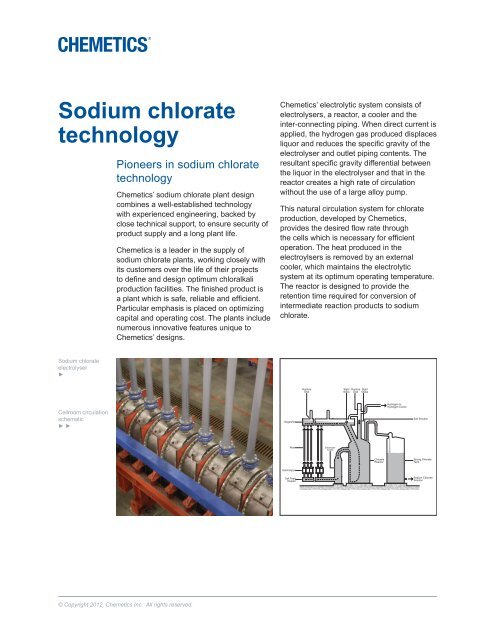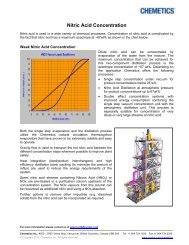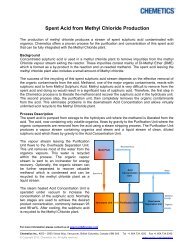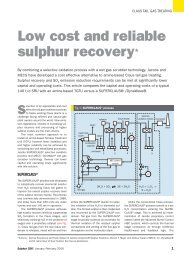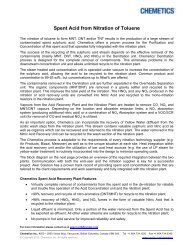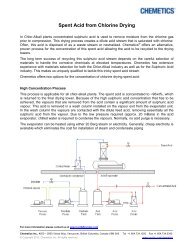Sodium chlorate technology - Jacobs Engineering
Sodium chlorate technology - Jacobs Engineering
Sodium chlorate technology - Jacobs Engineering
You also want an ePaper? Increase the reach of your titles
YUMPU automatically turns print PDFs into web optimized ePapers that Google loves.
<strong>Sodium</strong> <strong>chlorate</strong><br />
<strong>technology</strong><br />
<strong>Sodium</strong> <strong>chlorate</strong><br />
electrolyser<br />
►<br />
Cellroom circulation<br />
schematic<br />
► ►<br />
Pioneers in sodium <strong>chlorate</strong><br />
<strong>technology</strong><br />
Chemetics’ sodium <strong>chlorate</strong> plant design<br />
combines a well-established <strong>technology</strong><br />
with experienced engineering, backed by<br />
close technical support, to ensure security of<br />
product supply and a long plant life.<br />
Chemetics is a leader in the supply of<br />
sodium <strong>chlorate</strong> plants, working closely with<br />
its customers over the life of their projects<br />
to define and design optimum chloralkali<br />
production facilities. The finished product is<br />
a plant which is safe, reliable and efficient.<br />
Particular emphasis is placed on optimizing<br />
capital and operating cost. The plants include<br />
numerous innovative features unique to<br />
Chemetics’ designs.<br />
© Copyright 2012, Chemetics Inc. All rights reserved.<br />
Chemetics’ electrolytic system consists of<br />
electrolysers, a reactor, a cooler and the<br />
inter-connecting piping. When direct current is<br />
applied, the hydrogen gas produced displaces<br />
liquor and reduces the specific gravity of the<br />
electrolyser and outlet piping contents. The<br />
resultant specific gravity differential between<br />
the liquor in the electrolyser and that in the<br />
reactor creates a high rate of circulation<br />
without the use of a large alloy pump.<br />
This natural circulation system for <strong>chlorate</strong><br />
production, developed by Chemetics,<br />
provides the desired flow rate through<br />
the cells which is necessary for efficient<br />
operation. The heat produced in the<br />
electroylsers is removed by an external<br />
cooler, which maintains the electrolytic<br />
system at its optimum operating temperature.<br />
The reactor is designed to provide the<br />
retention time required for conversion of<br />
intermediate reaction products to sodium<br />
<strong>chlorate</strong>.<br />
Degasifier<br />
Electrolyzer<br />
Riser Electrolyte<br />
Cooler<br />
Cell Feed<br />
Header<br />
Rupture<br />
Disk<br />
Sight Rupture Sight<br />
Glass Disk Glass<br />
Chlorate<br />
Reactor<br />
Hydrogen to<br />
Hydrogen Cooler<br />
Salt Solution<br />
Strong Chlorate<br />
Tank<br />
<strong>Sodium</strong> Chlorate<br />
Solution
<strong>Sodium</strong> <strong>chlorate</strong><br />
block diagram<br />
►<br />
The sodium <strong>chlorate</strong> production rate is<br />
controlled by varying the direct current to the<br />
electrolysers and the desired <strong>chlorate</strong>/chloride<br />
concentration in the product is achieved by<br />
adjusting the brine feed to the system and by<br />
regulating the quantity of water evaporated<br />
from the process by the <strong>chlorate</strong> crystalliser.<br />
The <strong>chlorate</strong> solution product is displaced<br />
from the reactor and flows by gravity to the<br />
downstream plant areas.<br />
Our sodium <strong>chlorate</strong> plants can be tailored<br />
to meet each client’s individual needs by the<br />
option selection of the following:<br />
■ Number of electrolysers<br />
■ Number of cells per electrolyser<br />
■ Size of cell and its anode area (m2)<br />
■ Operating current density (kA/m2)<br />
Salt<br />
Dissolving<br />
Primary Brine<br />
Purification<br />
AC Power Supply<br />
Secondary<br />
Purification<br />
© Copyright 2012, Chemetics Inc. All rights reserved.<br />
<strong>Sodium</strong><br />
Chlorate<br />
Electrolysis<br />
DC<br />
Rectification<br />
Mother Liquor<br />
Crystalization<br />
& Drying<br />
Hydrogen<br />
Handling<br />
Crystal Product<br />
Handling<br />
Chemetics’ multi-monopolar cell sodium<br />
<strong>chlorate</strong> plant represents the state-of-the-art<br />
in materials of construction, performance and<br />
operability.<br />
Chemetics has been successful in assisting<br />
our customers in leveraging a competitive<br />
advantage by supplying safe, reliable, and<br />
price competitive plants throughout the<br />
world for close to 40 years. With our in-depth<br />
technical expertise and experience in sodium<br />
<strong>chlorate</strong> <strong>technology</strong>, plant design, and project<br />
execution, Chemetics has the necessary<br />
capability to deliver superior value and quality<br />
to our customers and their projects.<br />
Features:<br />
■ Highly efficient design for minimum power<br />
consumption.<br />
■ Compact electrolysers designed for<br />
minimum space requirements.<br />
■ Optimization of cell parameters such as<br />
electrode sizes, thickness, electrolytic gap<br />
and anode coating options.<br />
■ Durable materials of construction for low<br />
maintenance and long service.<br />
■ Proprietary steel cathode material to<br />
prevent hydrogen blistering in service.<br />
■ Technical service and warranty program<br />
on anode coatings and electrolyser<br />
components.<br />
Chemetics Inc. Phone: +1 604 734 1200<br />
Suite 200 – 2930 Virtual Way Fax: +1 604 734 0340<br />
Vancouver, British Columbia, Canada V5M 0A5 Email: chemetics.info@jacobs.com www.jacobs.com/chemetics


